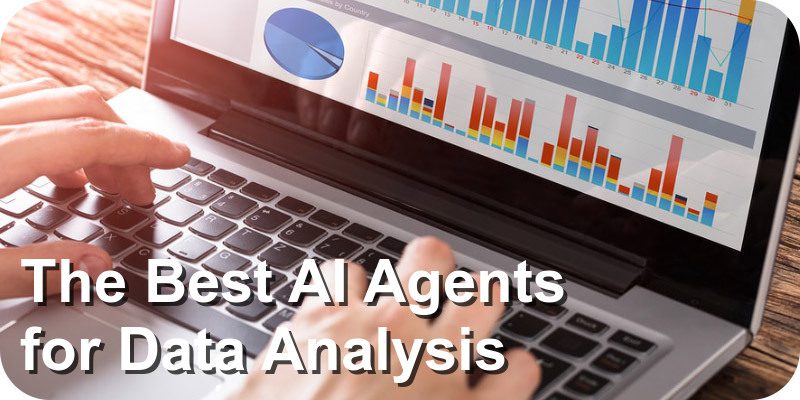The 28 Best AI Agents for Data Analysis to Consider in 2025


Solutions Review Executive Editor Tim King explores the emerging AI application layer with this authoritative list of the best AI agents for data analysis.
The proliferation of generative AI has ushered in a new era of intelligent automation — and AI agents are at the forefront of this transformation. From embedded copilots that analyze spreadsheets to autonomous agents that browse the web, write code, and synthesize complex data across systems, AI agents are already reshaping how forward-thinking organizations understand and act on information.
In this up-to-date and authoritative guide, we break down the top AI agents and agent platforms available today for data analysis, grouped into clear categories to help you find the right tool for your specific needs — whether you’re a data scientist building custom pipelines, a business analyst looking for quick insights, or a C-suite leader planning enterprise-scale AI adoption.
This resource is designed to help you:
-
Understand what makes AI agents different from traditional analytics tools
-
Explore the capabilities and limitations of each available agent or agent platform in the marketplace
-
Choose the best solution for your team based on use case, skill level, and scalability options
Whether you’re analyzing structured business data, extracting insights from text, detecting real-time anomalies, or deploying AI in high-security environments — there’s an AI agent for that.
Note: This list of the best AI agents for data analysis was compiled through web research using advanced scraping techniques and generative AI tools. Solutions Review editors use a unique multi-prompt approach to employ targeted prompts to extract critical knowledge to optimize the content for relevance and utility. Our editors also utilized Solutions Review’s weekly news distribution services to ensure that the information is as close to real-time as possible.
The Best AI Agents for Data Analysis
The Best AI Agents for Data Analysis: General-Purpose AI Agent Frameworks and Builders
Platforms that help developers and organizations build autonomous or semi-autonomous AI agents with flexible tooling and language model integration.
LAMBDA
Use For: No-code, multi-agent data analysis using natural language and large language models
LAMBDA, which stands for Large Model Based Data Agent, is a cutting-edge, open-source framework designed to make complex data analysis accessible through natural language and AI agent collaboration. Unlike traditional data tools that require programming, SQL, or data wrangling knowledge, LAMBDA allows users to interact with data by simply asking questions in plain English.
What makes LAMBDA unique is its ability to simulate a multi-agent conversation internally—a system of roles like “Data Finder,” “Insight Generator,” and “Result Summarizer”—that work together behind the scenes to answer user questions based on uploaded datasets. Whether you’re analyzing CSVs, sales reports, or research datasets, LAMBDA empowers users to reason about data, identify trends, and produce insights with zero coding.
Key Features:
- Upload tabular data (CSV, Excel, etc.) and interact using natural language
- Agents collaborate autonomously to analyze, explain, and summarize findings
- Uses LLMs (like GPT-4) to reason through data queries, filter results, and format outputs
- Provides detailed, interpretable, and iterative responses to follow-up questions
Get Started: LAMBDA is an excellent choice if you want to explore structured data interactively without writing code—ideal for rapid prototyping, educational settings, or research environments where usability and interpretability matter.
LangChain
Use For: Building custom AI agents and workflows that analyze, transform, and reason over data
LangChain is a powerful open-source framework that allows you to build custom AI agents and applications using large language models (LLMs). Unlike plug-and-play assistants, LangChain is a developer-first toolkit designed to chain multiple AI components together—including models, tools, APIs, databases, and memory—to solve complex, multi-step data analysis problems.
For example, you could use LangChain to build an agent that pulls in sales data, filters out anomalies, cross-references customer support logs, and summarizes the findings in natural language—all autonomously.
Key Features:
- Build autonomous agents and toolchains for data exploration and reporting
- Integrate with APIs, vector databases, Python scripts, and cloud tools
- Use natural language as the interface for structured data workflows
- Supports memory, document indexing, retrieval-augmented generation (RAG), and more
Get Started: Use LangChain when your team wants to go beyond pre-built agents and create tailored AI pipelines that pull from multiple sources, reason through logic, and produce actionable outputs. It’s perfect for AI-powered dashboards, RAG applications, and cross-system automation.
Microsoft AutoGen
Use For: Creating multi-agent AI systems that collaborate to solve complex data analysis tasks
AutoGen is an open-source framework developed by Microsoft that allows users to create multi-agent conversations and workflows using large language models (LLMs). It provides a flexible foundation for designing systems where multiple specialized AI agents can interact, reason, and delegate tasks to each other autonomously — making it one of the most powerful tools for complex, layered data analysis workflows.
AutoGen lets you define agents with specific roles—such as a Data Analyst Agent, a Code Execution Agent, a Reporting Agent, or even a QA Checker Agent—and allows them to communicate through structured dialogue. This architecture enables modular problem solving, where each agent contributes its expertise to a shared goal, such as transforming a dataset, generating visualizations, summarizing results, and validating outcomes.
Key Features:
- Supports multi-agent collaboration using LLMs (e.g., GPT-4, Azure OpenAI, Hugging Face)
- Allows natural language reasoning, code execution, data manipulation, and tool integration
- Enables complex workflows like data cleaning → analysis → visualization → reporting
- Agents can be embedded with custom tools (e.g., Python scripts, APIs, search functions)
Get Started: Use AutoGen when you need to break down a data analysis task into smaller, logically distinct parts—and want different AI agents to handle each step. Think of it as building your own data science team out of specialized LLM-powered agents.
BabyAGI
Use For: Autonomous task execution and iterative learning loops in lightweight AI workflows
BabyAGI is an open-source Python-based autonomous AI agent that mimics human-like task management and learning by using a feedback loop of planning, execution, and memory. It’s a minimalistic yet powerful framework for building agents that can generate tasks, prioritize them, and execute them autonomously using a large language model like GPT-4.
While the name “AGI” (Artificial General Intelligence) is aspirational, BabyAGI is not a true AGI system. Instead, it’s a smart, evolving tool for chaining tasks and learning from results, making it a creative and experimental platform for automated data analysis, research workflows, and task orchestration.
Key Features:
- Autonomous task generation, execution, and reprioritization
- Uses an embedded vector database (e.g., FAISS) for long-term memory and context
- Integrates with LLMs (e.g., OpenAI, Cohere, Azure) for reasoning and content generation
- Lightweight and customizable—ideal for rapid prototyping of data workflows
Get Started: Use BabyAGI when you want to experiment with autonomous agents that “think and do” iteratively — perfect for building data-focused agents that refine their own output over time, like internal research bots, data summarizers, or continuous insight generators.
Meta AutoGPT
Use For: Autonomous multi-step task execution for data analysis, research, and automation
Meta AutoGPT is an experimental, open-source autonomous AI agent framework inspired by the original Auto-GPT concept, with enhancements from Meta’s research into agent autonomy, reasoning, and planning. The goal of AutoGPT-style agents is to perform entire tasks from start to finish with minimal human input—by decomposing objectives, selecting tools, retrieving data, executing code, and iterating until the goal is reached.
While Meta has not released a polished, branded “AutoGPT” product per se, its research and community contributions to autonomous agent design have influenced how developers create and train agents that think, act, and adapt across multi-step analytical workflows. Often built on top of foundational models like LLaMA (Meta’s open-source large language model), these agents can be fine-tuned to handle specific data tasks such as crawling sources, cleaning data, applying logic, and generating final reports.
Key Features:
- Self-prompting agents that plan, execute, and revise tasks automatically
- Uses LLMs to generate goals, write and run code, analyze outputs, and adapt behavior
- Can chain together tools like file readers, API connectors, databases, and Python runtimes
- Suited for data processing pipelines, business intelligence automation, and research bots
Get Started: Use Meta-inspired AutoGPT setups when you want an AI agent to run full data analysis workflows on its own, especially in backend environments where you can chain logic, storage, and compute. Ideal for building hands-free analytics pipelines or research assistants that get smarter over time.
AgentBuilder.ai
Use For: No-code AI agent creation for document analysis, customer support, and internal data exploration
AgentBuilder.ai is a user-friendly platform that allows anyone — even without coding experience — to create and deploy custom AI agents that can analyze documents, answer questions, and perform light data analysis. Built to bridge the gap between AI capabilities and everyday workflows, AgentBuilder.ai is ideal for internal knowledge retrieval, client-facing chatbots, and smart assistants for PDFs, spreadsheets, and company data.
Unlike other developer-heavy frameworks like LangChain or AutoGen, AgentBuilder.ai is entirely drag-and-drop and natural language–driven. Users can upload files, configure agent behavior, set data sources, and embed the agents into websites, apps, or internal portals — all without writing a line of code.
Key Features:
- Upload and analyze documents, including PDFs, CSVs, and Word files
- Customize agent behavior and tone using natural language instructions
- Connect to multiple file types and knowledge bases for unified query responses
- Embed agents into websites, support desks, or internal dashboards
- Built-in memory and context management to retain conversation state
Get Started: Use AgentBuilder.ai when your team needs a quick, no-code way to analyze internal documents, streamline FAQs, or deploy intelligent assistants without involving engineering resources. Great for startups, SMBs, and enterprise teams seeking low-friction AI deployment.
DeepSeek Agent
Use For: Fully autonomous data-driven task execution, market research, and financial analysis
DeepSeek Agent is a next-generation open-source AI agent framework developed by the team behind DeepSeek, one of China’s most advanced LLM initiatives. DeepSeek Agent is designed to perform complex, multi-step tasks autonomously by combining large language models with reasoning, tool use, and memory — making it a powerful foundation for long-running data analysis workflows and research assistants.
Originally gaining attention in 2024 and 2025 as an emerging alternative to Western open-source agent frameworks (like AutoGPT or BabyAGI), DeepSeek Agent is now used by Chinese quantitative fund managers and developers building self-directed research and trading agents, highlighting its flexibility and scalability.
Key Features:
- Autonomous task decomposition and execution powered by DeepSeek-VL and DeepSeek-Coder models
- Supports multi-modal inputs (text, code, PDFs, charts) and tool calling
- Integrates with web browsing, file parsing, code execution, and API calls
- Optimized for long-context reasoning and iterative workflows
- Customizable prompt chains and agent roles for multi-agent coordination
Get Started: Use DeepSeek Agent when you need to run autonomous AI tasks over time, such as market analysis, investment research, competitive intelligence, or technical document synthesis — especially if you want open-source control and multi-agent reasoning capabilities.
Convergence AI Proxy 1.0
Use For: Human-like web interaction, autonomous task execution, and data gathering across the internet
Convergence AI Proxy 1.0 is an experimental autonomous AI agent developed to act as a proxy for human web activity — browsing websites, clicking links, submitting forms, and gathering data as if it were a person. Designed with the goal of enabling full-task automation, Proxy 1.0 can read, reason, and act across digital environments with minimal human intervention.
Where traditional AI assistants answer questions based on static inputs, Proxy 1.0 simulates real-world browsing behavior to complete more dynamic, open-ended tasks like competitive research, market monitoring, web scraping, and real-time information discovery. It’s part of a new wave of agentic AI designed for web-native autonomy.
Key Features:
- Human-like interaction with live websites (clicking, navigating, filling forms)
- Performs complex, multi-step tasks based on a single natural language prompt
- Combines large language models with reasoning, planning, and tool use
- Can scrape, parse, and summarize external content in real-time
- Operates as a general-purpose AI browsing assistant
Get Started: Use Proxy 1.0 when your data analysis task involves navigating the open web — whether it’s pulling current prices, monitoring competitors, gathering content, or researching hard-to-reach topics. It’s ideal for situations where static datasets don’t cut it and live digital interaction is required.
Want the full list? Register for Insight Jam [free], Solutions Review‘s enterprise tech community enabling the human conversation on AI, to gain access here.































